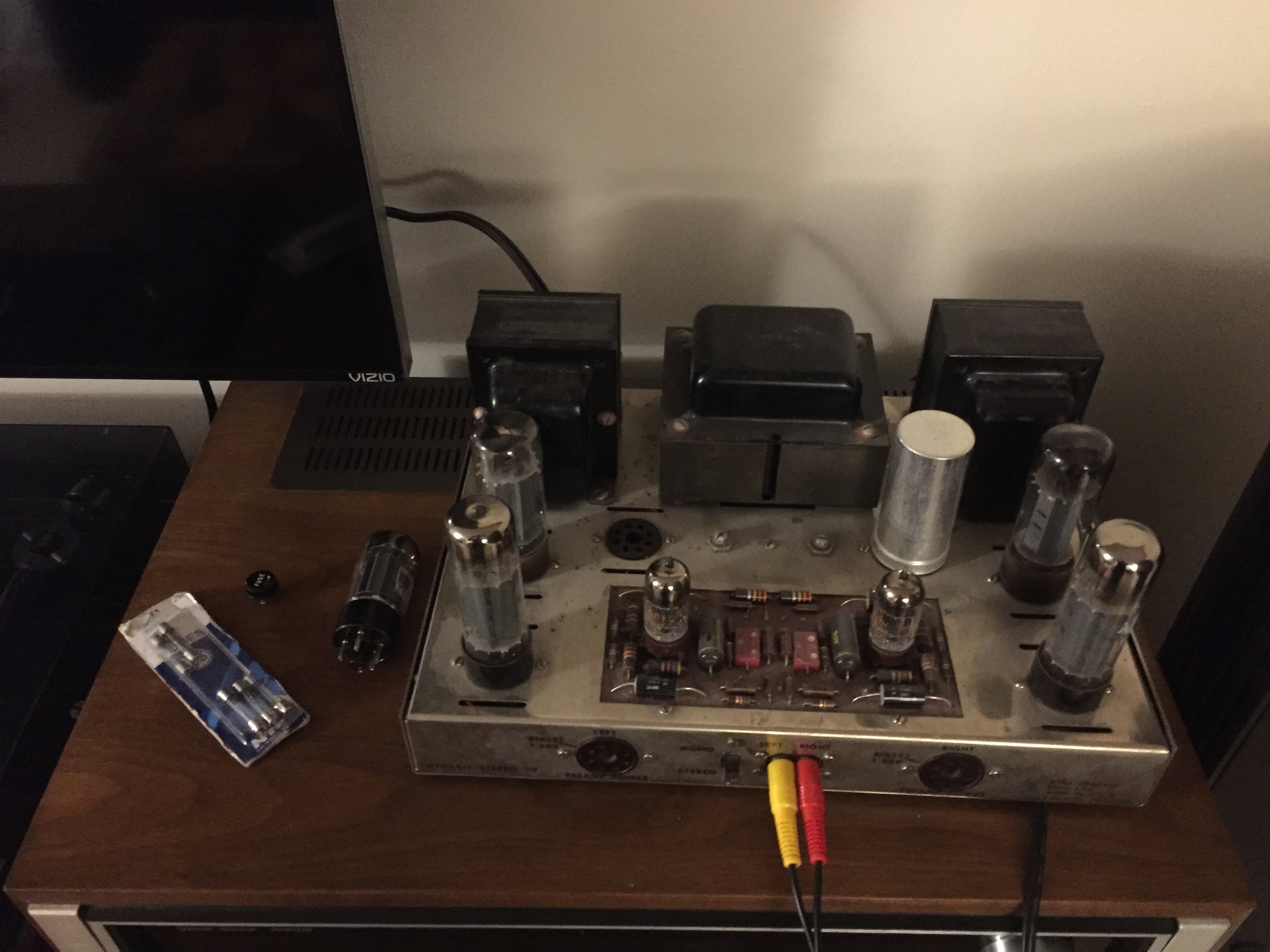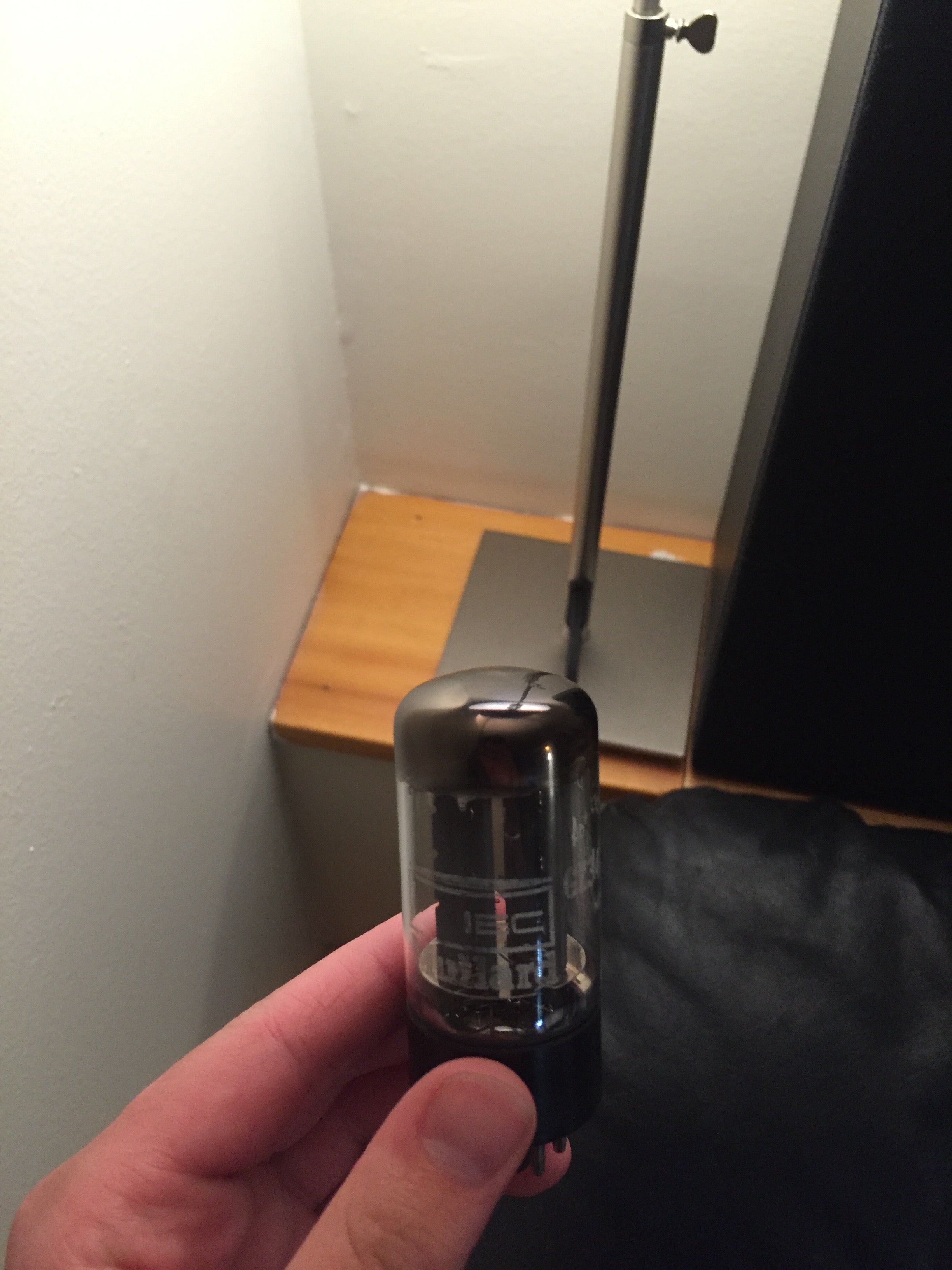 "gmctavish needs more space" (gmctavish)
"gmctavish needs more space" (gmctavish)
04/26/2016 at 23:46 ē Filed to: Audiostielock
 0
0
 18
18
 "gmctavish needs more space" (gmctavish)
"gmctavish needs more space" (gmctavish)
04/26/2016 at 23:46 ē Filed to: Audiostielock |  0 0
|  18 18 |

On the weekend I turned everything on to watch TV, and as soon as the Dynaco started to warm up it began to hum loudly and then abruptly shut off. Oh good. Pulled the fuse, it was very blown. Yesterday my friend who is the actual owner of the amp came over with more fuses to try again and see what wasnít warming up/warming up too much. Everything but the rectifier started to warm up, and after a few seconds the fuse blew again. his dad has a tube tester, but itís on the island, so heís just gonna use the base of the rectifier to make a solid state one, involving diodes or something.

The rectifier and two of the tubes are original, from 1959, so itís understandable that it finally bit the dust. Oh well, time to un-biamp the speakers in the meantime so Iím not saddled with only the TVs internal garbage speakers.
 gmporschenut also a fan of hondas
> gmctavish needs more space
gmporschenut also a fan of hondas
> gmctavish needs more space
04/26/2016 at 23:52 |
|
is there a tube amp for dummies book? these always look so cool.
 gmctavish needs more space
> gmporschenut also a fan of hondas
gmctavish needs more space
> gmporschenut also a fan of hondas
04/27/2016 at 00:00 |
|
There might be, I havenít looked other than random googling. What little I know is what Iíve learned from my friend. They do look and sound awesome
 unclevanos (Ovaltine Jenkins)
> gmctavish needs more space
unclevanos (Ovaltine Jenkins)
> gmctavish needs more space
04/27/2016 at 00:07 |
|
This was back in the day when people walked uphill both ways bare foot on the way to school in the snow.
 I Will Always Be The Honey Badger
> gmctavish needs more space
I Will Always Be The Honey Badger
> gmctavish needs more space
04/27/2016 at 00:10 |
|
I think itís awesome that modern electronics still have the same analog input jack that was invented in the 1940s.
 My bird IS the word
> gmctavish needs more space
My bird IS the word
> gmctavish needs more space
04/27/2016 at 00:11 |
|
Slightly off topic- can you reccomend a good electronics book for the uninitiated? starting to run into electical projects/ issues in my car and I want to be able to do some simple fabricating.
 TheLOUDMUSIC- Put it in H!
> gmctavish needs more space
TheLOUDMUSIC- Put it in H!
> gmctavish needs more space
04/27/2016 at 00:11 |
|
oooooh mullards
Were they red plating or something? The flashing in that still looks good, and a lot of the times something like that can be caused by a capacitor giving up the ghost.
 gmctavish needs more space
> TheLOUDMUSIC- Put it in H!
gmctavish needs more space
> TheLOUDMUSIC- Put it in H!
04/27/2016 at 00:25 |
|
It just wasnít warming up at all, we were a bit confuse because all the tubes looked fine, but the capacitors were changed recently so I dunno, itís worth checking
 gmctavish needs more space
> My bird IS the word
gmctavish needs more space
> My bird IS the word
04/27/2016 at 10:13 |
|
I'm afraid I can't, what little I know about electronics is what I've learned from a friend or from googling things
 TheLOUDMUSIC- Put it in H!
> gmctavish needs more space
TheLOUDMUSIC- Put it in H!
> gmctavish needs more space
04/27/2016 at 15:26 |
|
Iíd have someone go through it. Tubes, despite what a lot of people will tell you, are shockingly durable.
 TheLOUDMUSIC- Put it in H!
> unclevanos (Ovaltine Jenkins)
TheLOUDMUSIC- Put it in H!
> unclevanos (Ovaltine Jenkins)
04/27/2016 at 15:27 |
|
And guitar players.
 gmctavish needs more space
> TheLOUDMUSIC- Put it in H!
gmctavish needs more space
> TheLOUDMUSIC- Put it in H!
04/27/2016 at 15:37 |
|
I'll see if my friend is cool with it, it's his call to make, not mine. He's been wanting to run a solid state rectifier for a while so I think he's using this as an excuse to make one
 MM54
> gmctavish needs more space
MM54
> gmctavish needs more space
04/27/2016 at 20:03 |
|
IEC Mullards are decent, not surprised it made it this long. Whatís the tube number? I probably have one (or ten) in my cabinet.
 MM54
> gmctavish needs more space
MM54
> gmctavish needs more space
04/27/2016 at 20:04 |
|
Heads up with the SS rectifier - you get the full 1.414*VAC DC from a silicon diode (well, minus .7 volts), when a tube rectifier is lossy enough you are only around 1.1-1.2, so your filter caps may not like it (i.e. pop) if theyíre old and/or not rated for much above the existing B+
 gmctavish needs more space
> MM54
gmctavish needs more space
> MM54
04/27/2016 at 20:07 |
|
It says GZ34/5Ar4, 1022-824. Iím not sure which of those is the tube number
 gmctavish needs more space
> MM54
gmctavish needs more space
> MM54
04/27/2016 at 20:07 |
|
I think i got the gist of that, but I really need to read more on tube amps, my knowledge is extremely basic
 MM54
> gmctavish needs more space
MM54
> gmctavish needs more space
04/27/2016 at 20:14 |
|
GZ34 would be the European designation, 5AR4 would be the US designation. 1022-824 would be Mullard batch/factory codes, which at one point I knew but have since forgotten.
Shouldnít be hard to replace if you want to go that way, though honestly for hi-fi, youíre probably better off with a silicon recitifer, since itís before the filters shot noise shouldnít be an issue. Thereís also the bonus of a modern diode being able to feed a filter bank with a much higher capacitance than a tube can to help keep the supply quiet.
 gmctavish needs more space
> MM54
gmctavish needs more space
> MM54
04/27/2016 at 20:24 |
|
Oh okay,good to know.
I think thatís along the lines of my friends reasoning for not sticking with a tube rectifier, I dunno when heís gonna make it so for now Iíve gone back to ďonlyĒ the 9090. Bi-amping with the Dynaco has definitely spoiled me
 MM54
> gmctavish needs more space
MM54
> gmctavish needs more space
04/27/2016 at 20:27 |
|
Basically, know this:
AC Voltage: Itís measured from your wall, and out of transformers, at RMS which is sort of an average-energy through the sine wave of the voltage. This mean the peaks of the wave, for a sine wave like out of your wall, are the square root of 2 times the RMS voltage (because math) - meaning your 120 at the wall is about 170V peak, and the 350VAC (estimating here, I donít know your particular amp) on the PT secondary is actually about 495V peak.
When you rectify AC into DC, you basically use some diodes to take either the top half of the wave, or both halves but flip the bottom side off. This gives you pulsed power from 0-peak power at either 60 or 120Hz (assuming this is plugged into the wall in the US) depending on if itís a half- or full-wave rectifier. The filter caps smooth this out into constant DC voltage equal to that at the peak of the pulse.
This happens because a diode, whether it be a silicon diode ala 1N4007 or a vacuum diode (rectifier tubes are just two vacuum diodes in the same tube), will only conduct current one way. In order to conduct at all, there is a ďForward VoltageĒ which is the minimum voltage you need - this is subtracted from the final voltage coming out. A silicon diode is usually about 0.7V to forward, tube vary quite a bit but are much more. Another thing is that tubes are lossy, so you lose more voltage there.
What this boils down to is that the 350Vrms (495Vp) coming out of the power transformer going through a tube rectifier is only going to be, say 400VDC on the filters and the voltage rail in general. Swapping that tube rectifier out for a silicon one removes all the associated losses, and you can end up with 480V or more on the filters/rail.
This means that if you have filter caps rated for 450VDC, youíre now nearly 10% over their rated voltage. If you have caps that are decades old, but have only ever been running at 400V, 480 will not be easy on them, either. Just something to keep in mind; if the filters are fairly new and rated for the full voltage the silicon rectifier will put out youíll be good to go.
(Source: Spent several years servicing/designing/building tube equipment before and during the obtaining of a degree in Electrical Engineering)